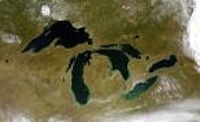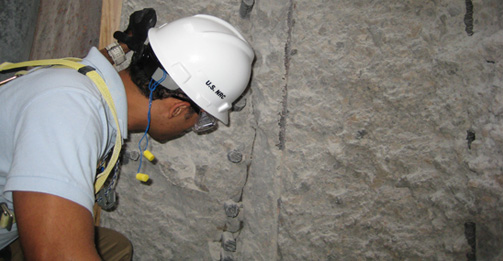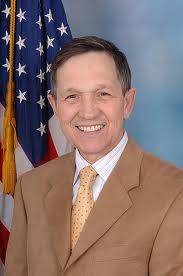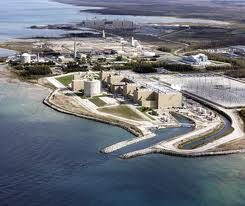What Humpty Dumpty doesn't want you to know: Davis-Besse's cracked concrete containment snow job
 U.S. Congressman Dennis Kucinich (D-OH)Beyond Nuclear's Kevin Kamps has prepared a comprehensive backgrounder about an environmental coalition's (including Citizens Environmental Alliance of Southwestern Ontario, Canada, just across Lake Erie) efforts to win a hearing against the Davis-Besse atomic reactor's proposed 20-year license extension based on the safety risks presented by its severely cracked shield building. FirstEnergy Nuclear Operating Company (FENOC) claims the cracking was caused by the Blizzard of 1978, is not aging related, and will be easily solved by the application of a weather sealant (albeit 40 years late). The backgrounder, prepared for a special NRC meeting about the shield building cracking to be held on Nagasaki Day (Thursday, August 9) in Oak Harbor, Ohio, reports on NRC's response documents to a Beyond Nuclear Freedom of Information Act (FOIA) request, as well as recent revisions to FENOC's root cause reports and aging management plan. Also contained in the backgrounder are citations to the environmental coalition's four supplements to its original cracking contention, over the course of many months. (See links to FOIA documents here.)
U.S. Congressman Dennis Kucinich (D-OH)Beyond Nuclear's Kevin Kamps has prepared a comprehensive backgrounder about an environmental coalition's (including Citizens Environmental Alliance of Southwestern Ontario, Canada, just across Lake Erie) efforts to win a hearing against the Davis-Besse atomic reactor's proposed 20-year license extension based on the safety risks presented by its severely cracked shield building. FirstEnergy Nuclear Operating Company (FENOC) claims the cracking was caused by the Blizzard of 1978, is not aging related, and will be easily solved by the application of a weather sealant (albeit 40 years late). The backgrounder, prepared for a special NRC meeting about the shield building cracking to be held on Nagasaki Day (Thursday, August 9) in Oak Harbor, Ohio, reports on NRC's response documents to a Beyond Nuclear Freedom of Information Act (FOIA) request, as well as recent revisions to FENOC's root cause reports and aging management plan. Also contained in the backgrounder are citations to the environmental coalition's four supplements to its original cracking contention, over the course of many months. (See links to FOIA documents here.)
Kevin will speak, along with Don't Waste Michigan's Michael Keegan and Terry Lodge, Toledo based attorney who represents the coalition, at a press conference before the NRC meeting, at 5:30 PM at the Oak Harbor High School. U.S. Representative Dennis Kucinich (D-OH, photo at left), a long-time Davis-Besse watchdog, who has outed much of the truth about the severity of the cracking over the past 10 months, will also take part in the press conference.
 admin
admin
In an article entitled "Public grills NRC officials on Davis-Besse, The Toledo Blade has reported:
"...About a dozen members of several anti-nuclear groups, including Beyond Nuclear, Citizens Environment Alliance of Southwestern Ontario, and Don't Waste Michigan, held a news conference in front of the high school before the hearing. They said they have received part of the documentation from a Freedom Of Information Act request for the NRC's research and findings surrounding the cracking.
A summary of those findings released Wednesday by Beyond Nuclear derided the blizzard explanation and accused nuclear officials of lying about the cracking's severity.
The group accused FENOC and NRC officials of rushing through a restart decision in December, less than two months after the first crack was discovered, so that 'FENOC executives and shareholders can make killer profits, salaries, and returns on their investment from electricity sales by a reactor that should have long ago been shut down for good.'
'How many radioactive bullets can we dodge at Davis-Besse? We cannot let this 35-year long 'game' of Radioactive Russian Roulette go on for another 25 years,' the report states.
Kevin Kamps of Beyond Nuclear said during the meeting that an NRC employee reported in the study that he was concerned the concrete would fall, even under smaller stressors, and another was concerned with, not whether the concrete would fall off, but whether the Shield Building itself would stay standing..."
ABC13 also interviewed Kevin (broadcast report and shorter written summary). WNWO reported: "Kevin Kamps [of the] the watchdog organization Beyond Nuclear, stressed the importance of a 'carbon-free and nuclear-free' economy. He raised concern over past nuclear disasters at Three Mile Island, Chernobyl, and Fukushima. He questioned, 'Where is it going to happen next?'" The Sandusky Register reported the cracking is in violation of Davis-Besse's design and licensing bases; at the meeting, an NRC official admitted it is only requiring FENOC to provide "a plan for a plan" to "restore conformance" by Dec. 2012. The Port Clinton News Herald, WNWO/Northwestohio.com and the Cleveland Plain Dealer has also reported on this story. The Toledo Blade also ran a lead up article, as well as an editorial. The Cleveland Plain Dealer has also published an editorial. WOIO and WKSU have also reported on this story.









